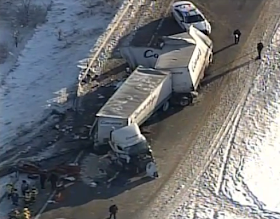With so many deadly collisions involving semi trucks, we thought that it would be good to provide this brief refresher on safe driving tips
Case #1: A
50-year-old male truck driver was traveling after dark on an unlit highway,
when he unknowingly approached a semi that had slowed to a stop due to road
construction.
With only a few feet to spare, the operator attempted to
brake and swerve to the right, but failed to avoid collision on the driver’s
side of his truck.
The truck driver was speaking on his cellular device at the
time of the incident, although it is unclear if he was using a Bluetooth or
other hands-free device.
He died at the scene.
Case #2: A
57-year-old male truck driver was traveling during daylight hours along the
interstate, when he approached a truck traveling at 55 mph with its emergency
flashers engaged.
Both trucks were in the right-side lane. At the last second,
the operator braked and swerved, attempting to avoid a collision, but struck the
slower vehicle.
The entire driver’s side of the semi truck was completely
sheered off. Despite the fact that the
driver was wearing a seatbelt, he was ejected and killed.
What steps can be
made to prevent such incidents?
·
Motor carriers should consistently train their
drivers on the importance of speed and space management.
·
Maintain awareness of distracted drivers sharing
the road.
·
Reduce distractions. Limit hands-free cell phone
use to emergencies only.
·
Perform a thorough pre-trip and post-trip
inspection to ensure your brakes, turn signals and headlights are in good
working order.
·
Buckle up! Safety restraint use can save your
life.
HOW YOU CAN PREVENT REAR-END COLLISIONS
Carriers should consistently train their drivers on the importance
of speed and space management. Safety training being provided by management
plays an integral role in the reduction of rear-end collisions as well as many
other injuries. Trainings should focus on factors that influence the minimum
amount of space needed, such as weather conditions, speed, total weight of the
truck, and traffic.
·
Maintain awareness of distracted drivers sharing
the road. The road is a more dangerous place to drive now than it ever has
been. One contributing factor is the distracted driving habits of other people
that share the road. Many people are unaware of the required stopping distance
of a fully loaded semi-truck and may pull directly out in front of you or
swerve into your path. Maintain awareness of other vehicles at all times when
they are in your vicinity so that you will have proper time to react to their
movements.
·
Reduce distractions. Limit hands-free cell phone
use to emergencies only . As of January 2012, the Federal Mo-tor Carrier Safety
Administration (FMCSA) released rulings that ban both texting and using a
handheld cell-phone device while driving a commercial truck. Research has shown
that the odds of being in a crash are 23.2 times higher for commercial motor
vehicle (CMV) operators who text while driving.(Ref. 1).
·
Perform a thorough pre-trip and post-trip
inspection to ensure your brakes, turn indicators and headlights are in good
working order. The FMCSA mandates that every commercial driver must complete a
pre-trip inspection before the beginning of each work day to ensure good
working order of brakes, turn signals, and headlights. (Ref. 2).
·
Buckle up! If all else fails, restraint use can
save your life. The FMCSA requires that a seatbelt is used in any CMV that has
one installed in the driver’s seat.(Ref. 3) Wearing a seatbelt should be
non-negotiable when occupying a CMV. Research has shown that in a semi truck
collision, the odds of being injured are 2.25 times higher for both semi truck
drivers and sleeper berth occupants who do not wear occupant safety restraints
compared to those who do. (Ref. 4).
IF YOU MUST GO, THEN
TAKE IT SLOW. AS A REMINDER, ROADS
CAN STILL BE ICY AND DRIVERS SHOULD BE EXTRA CAUTIOUS, MAINTAIN CONTROL OF
THEIR VEHICLE, AND BE MINDFUL OF OTHER VEHICLES ON THE ROAD AROUND THEM.
GREAT RISKS ARE FACED BY FIREFIGHTERS, POLICE OFFICERS, EMS
WORKERS, AND PUBLIC WORKS/HIGHWAY WORKERS EVERY SINGLE DAY AS THEY OPERATE ON
THE ROADWAY.
SLOW DOWN DURING BAD WEATHER AND REDUCE YOUR SPEED AS YOU
APPROACH EMERGENCY VEHICLES WORKING ON THE HIGHWAY.
References:
1.
Hickman, JS., Hanowski, R. (2012) An assessment
of commercial motor vehicle driver distraction using naturalistic driving data.
Traffic Injury Prevention, 13(6).
2.
“Driver Inspection”, 49 C.F.R. § 396.13 (2011).
Web.
3.
“Use of Seat Belts”, C.F.R. § 392.16 (2011).
Web.






